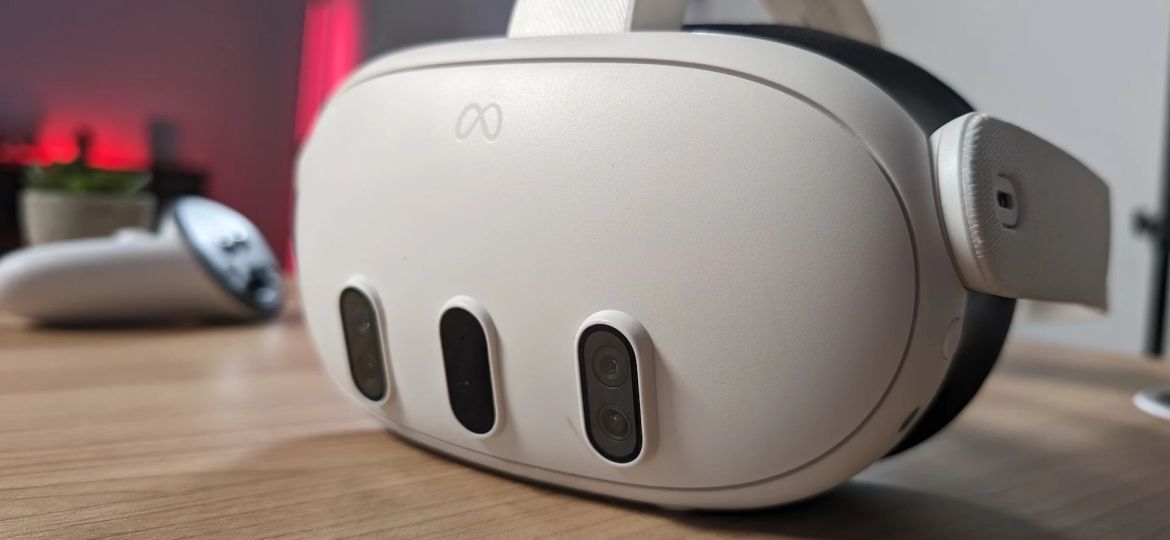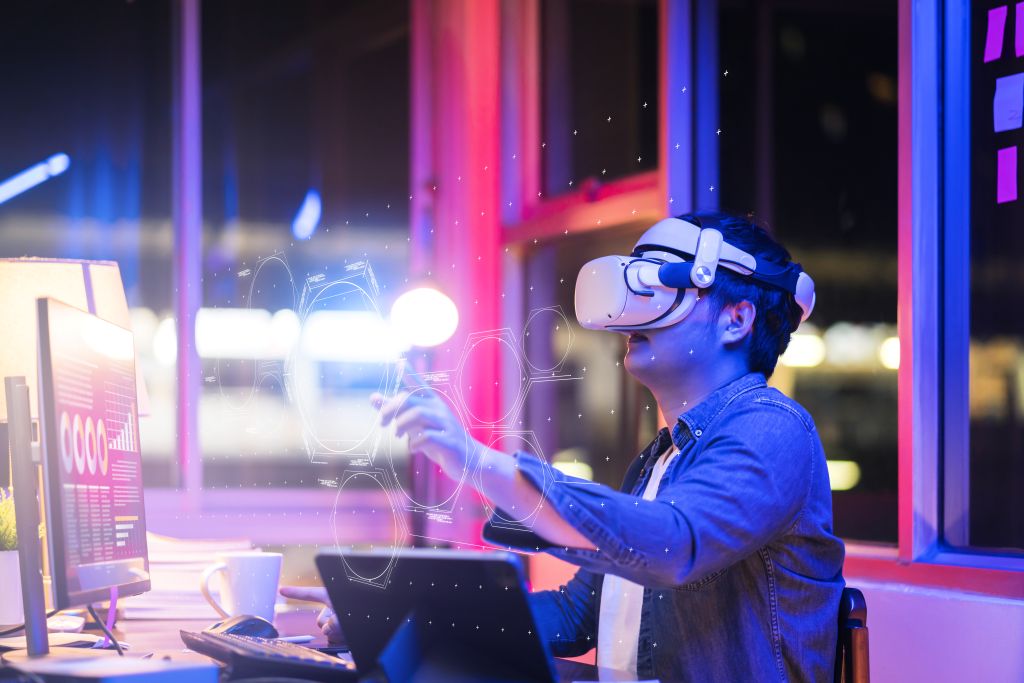
Exploring Mixed Reality with Meta Quest 3 Passthrough
Mersus Technologies recently acquired the latest Meta Quest 3 headsets, and after several weeks, it’s time to present our review. In this blog post, we’ll be focusing on one of the standout features of the Meta Quest 3 – its highly anticipated Augmented Reality capabilities.
For years, the debate has raged on about whether Virtual Reality or Augmented Reality holds the upper hand in the immersive technology realm. At Mersus Technologies, we have always maintained that this debate is somewhat misplaced. VR and AR each possess their unique strengths, catering to distinct use cases. With the emergence of headsets like the Meta Quest 3, it appears we may finally move beyond the perennial “which is better” discourse.
To clarify the distinction, VR immerses users in interactive virtual environments, making it ideal for scenarios where complete focus and immersion are paramount, such as in training. AR, on the other hand, overlays digital content onto the real world, proving invaluable in applications that require real-time information augmentation, like providing labels and directions in real world environments.
Now, the central question on our minds is whether the Meta Quest 3’s passthrough feature can effectively bridge the worlds of VR and AR. Join us as we delve into our insights.
The Meta Quest 3’s Passthrough Feature: A Closer Look
Let’s begin with the fundamental details.
The Meta Quest 3 stands as the latest entrant in the immersive technology landscape, generating significant attention. It represents a convergence of both VR and AR, reshaping how we engage with digital content.
Now, let’s turn our attention to the passthrough feature. But what precisely is passthrough, and how does it distinguish itself from traditional augmented reality?
In conventional augmented reality, digital information overlays the user’s real-world view, as seen in applications like Pokémon GO. Passthrough, however, represents a more immersive iteration of AR. With the Meta Quest 3’s passthrough feature, users don’t merely encounter fragments of digital content in their real environment; they become fully immersed in it.
What sets the Meta Quest 3 apart from its predecessors are the notable enhancements. This new headset boasts enhanced graphics, smoother tracking, and an overall more seamless experience.
Real-World Applications of Passthrough in Meta Quest 3
The Meta Quest 3’s passthrough technology opens up a world of possibilities in various real-world applications. Let’s delve into some of the current use cases that showcase its versatility
Gaming
Gaming takes on a whole new dimension with the Meta Quest 3’s passthrough feature. Hauntify is a horror game that allows you to scan your room, bringing the horror right into your real environment (“No thank you” -Fiona). Spatial Ops is a shooter that allows multiple players to move around obstacles to defeat each other, but it appears to work best if you have a large open area in which to play. Defy Gravity is a racing game where you can build custom tracks in your own space and race cars around them, offering ways to make a fun and imaginative use of your room and furniture. Yuki is a game where you play a space explorer battling hoards of alien baddies. Where the AR factor comes in is this game has portals open in your room that allow the baddies to pour out. Your environment starts to look like a queasy mix of the real world and the alien one – but I must point out that the game is designed in such a way that it is not going to make players feel nauseous! Demeo was an old favourite of mine (-Fiona) on the Quest 2, and the version on the 3 has more detailed graphics that look amazing when used with the passthrough to show your real room. However, you do need a room with a big open space in it to get the full use out of the large game board that can be walked around and interacted with from different angles.
So, as you can see, even though we are not a games studio, the kinds of innovations we see in these games allow lots of food for thought in how a mixed reality headset could be used in other scenarios such as training, which is what we are mainly interested in.
Productivity
The Meta Quest 3’s passthrough technology doesn’t just enhance gaming and entertainment; it also offers a significant boost to productivity. Users can seamlessly transition between their physical workspace and virtual screens, making multitasking more efficient than ever before. This feature is particularly valuable for professionals in fields such as 3D modelling, design, and data visualisation applications.
What sets the Meta Quest 3 apart is its user-friendly approach to mixed reality. With just a tap near your temple, you can effortlessly switch between full immersion and augmented reality. This versatility is a game-changer, allowing users to work with a variety of programs and devices seamlessly. Whether you’re deep into a VR design session or need to quickly access real-world data, the Meta Quest 3 adapts to your needs, making it a versatile tool for professionals across industries.
These are just a few examples, but the potential applications extend far beyond these realms.

Augmented Reality’s Impact on Our Daily Lives
Augmented reality, driven by the Meta Quest 3’s passthrough feature, is ushering in a new era of blending the digital and physical worlds. Here’s how it’s making a significant impact across various industries:
- Education – In the realm of education, passthrough technology revolutionises the way students learn. Imagine walking through historical sites with augmented historical information overlaid onto your surroundings or conducting virtual dissections in biology class. The Meta Quest 3 brings learning to life in ways we never thought possible.
- Healthcare – Medical professionals can use passthrough to access patient data in real time while performing surgeries or consultations. It aids in remote assistance during critical procedures, improving patient outcomes and reducing errors.
- Architecture & Design – Architects and designers benefit from the ability to overlay digital blueprints onto physical spaces, enabling more precise planning and visualisation. This technology enhances collaboration and streamlines the design process.
The possibilities are limitless, and these examples are just the tip of the iceberg.
Future Possibilities and Predictions
As technology continues to evolve, the Meta Quest 3’s passthrough feature is poised for even greater advancements. Here are some predictions and potential trends:
- Enhanced Interactivity – Passthrough technology may become more interactive, allowing users to manipulate and interact with digital objects in more intuitive ways.
- Industry-Specific Solutions – We anticipate the development of specialised applications tailored to specific industries, such as medical training simulations and virtual tourism experiences.
- Seamless Integration – Future iterations of the Meta Quest 3 could seamlessly integrate with smart home systems, offering enhanced control and customisation of your physical environment.
The Meta Quest 3’s passthrough feature represents a significant leap forward in mixed reality technology. While not perfect, the Quest 3 represents significant progress. We were particularly impressed with the improvements in its tracking capabilities. Its real-world applications will continue to span various industries, promising a future where digital and physical worlds coexist seamlessly.